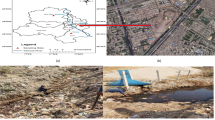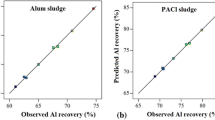Abstract
Besides particulate solids, colloids, and some natural organic substances, sludge from drinking water treatment plants (SDWTP) also contains Aluminum (Al) and Iron (Fe) compounds with the formation of Al(OH)3, Fe(OH)3 from the flocculation hydrolysis process. This paper reports the results of an exploratory experimental study to prepare a coagulant solution from SDWTP and utilize it for phosphorus treatment with the formation of PO43− as testing. The study used the Direct Titration method (DTM) and Reverse Titration method (RTM) for determining the content of Al3+ and Fe3+ contained in sludge samples, which were taken from the silt tank of two feedwater treatment plants at Daklak province, Vietnam. The study carried out series of experiments in the laboratory to recycle coagulants solution (Fe2(SO4)3, Al2(SO4)3) at different conditions: the ratio of mixing (sludge: sulphuric acid), reaction time, reaction temperature. The results showed that two sludge samples contained content of Al3+ higher than Fe3+, the content of Al3+ and Fe3+ are 1.762 mg.g−1, 0.028 mg.g−1 for Buon Ho plant sample (BHS) and 1.748 mg.g−1, 0.036 mg.g−1 for Eachu-Cap plant sample (ECS), respectively. At optimal conditions: the ratio of mixing is 10 g of sludge: 8 mL H2SO4 5 M, 60% of humidity; the reaction time is 5 h and 90 ℃ is the suitable reaction temperature. The efficiency of preparing is quite high, reaching 90.73% for Al3+ and 88.89% for Fe3+, respectively. Performance of orthophosphate treatment has reached 98,74% at the optimal conditions: pH 6, the volume of coagulant is 2.5 mL/200 mL wastewater, stirring time is 25–30 min. Besides, the efficiency of this testing is lower than that of Al2(SO4)3 insignificantly.
Access this chapter
Tax calculation will be finalised at checkout
Purchases are for personal use only
Similar content being viewed by others
References
Ahmad, T., Ahmad, K., Ahad, A., Alam, M.: Characterization of water treatment sludge and its reuse as a coagulant. J. Environ. Manage. 182, 606–611 (2016)
Barakwan, R., Hardina, T., Trihadiningrum, Y., Bagastyo, A.: Recovery of alum from Surabaya water treatment sludge using electrolysis with carbon-silver electrodes. J. Ecol. Eng. 20(7), 126–133 (2019). https://doi.org/10.12911/22998993/109861
Clark, T., Stephenson, T.: Development of a jar testing protocol for chemical phosphorus removal in activated sludge using statistical experimental design. Water Res. 33(7), 1730–1734 (1999)
Evuti, A.M., Lawal, M.: Recovery of coagulants from waterworks sludge: a review. Adv. Appl. Sci. Res. 2(6), 410–417 (2011)
Ishikawa, A., Sasaki, M., Narita, S., Takeuchi, A., Ohki, H., Yoshino, K.: Chromatographic formation of a triadic band of lithium in hydrated LTA zeolite: an investigation on lithium isotope separation effects by ion exchange. Microporous Mesoporous Mater. 248, 115–121 (2017)
Lam, M.T., Nguyen, N.T.: Research and propose treatment technology, make use of sludge and sludge separating water from water supply plants of Ho Chi Minh City. J. Environ. 9 (2013)
Nair, A.T., Ahammed, M.: The reuse of water treatment sludge as a coagulant for post-treatment of UASB reactor treating urban wastewater. J. Clean. Prod. 96, 272–281 (2013)
Nguyen, V.R., Tran, T.T.: Chemical Analysis Textbook - Part 1: Quantitative Analysis of Chemistry. Vietnam National University, Hanoi (2006)
Rozhkovskaya, A., Rajapakse, J., Millar, G.J.: Synthesis of high-quality zeolite LTA from alum sludge generated in drinking water treatment plants. J. Environ. Chem. Eng. 9(2), 104751 (2021). https://doi.org/10.1016/j.jece.2020.104751
Scalize, P.S., Souza, L., Albuquerque, A.: Reuse of alum sludge for reducing flocculant addition in water treatment plants. Environ. Prot. Eng. 45(1) (2019)
Truong, T.D., Nguyen D.T., Vu, T.T.T.: Phosphorus removal method. J. Ho Chi Minh City Univ. Technol. (2010)
Yang, L., Wei, J., Zhang, Y., Wang, J., Wang, D.: Reuse of acid coagulant-recovered drinking waterworks sludge residual to remove phosphorus from wastewater. Appl. Surf. Sci. 305, 337–346 (2014)
Zhou, Z., et al.: Optimized removal of natural organic matter by ultrasound-assisted coagulation of recycling drinking water treatment sludge. Ultrason. Sonochem. 48, 171–180 (2018). https://doi.org/10.1016/j.ultsonch.2018.05.022
Author information
Authors and Affiliations
Corresponding author
Editor information
Editors and Affiliations
Rights and permissions
Copyright information
© 2022 The Author(s), under exclusive license to Springer Nature Switzerland AG
About this paper
Cite this paper
Minh, H.T.T., Gia, D.H. (2022). Preparation of Coagulants (Fe2(SO4)3, Al2(SO4)3) by Reusing Sludge from the Feedwater Treatment Plant and Testing the Ability of Orthophosphate (PO43−) Removal. In: Long, B.T., Kim, H.S., Ishizaki, K., Toan, N.D., Parinov, I.A., Kim, YH. (eds) Proceedings of the International Conference on Advanced Mechanical Engineering, Automation, and Sustainable Development 2021 (AMAS2021). AMAS 2021. Lecture Notes in Mechanical Engineering. Springer, Cham. https://doi.org/10.1007/978-3-030-99666-6_91
Download citation
DOI: https://doi.org/10.1007/978-3-030-99666-6_91
Published:
Publisher Name: Springer, Cham
Print ISBN: 978-3-030-99665-9
Online ISBN: 978-3-030-99666-6
eBook Packages: EngineeringEngineering (R0)




